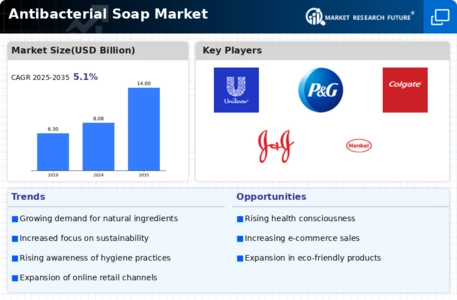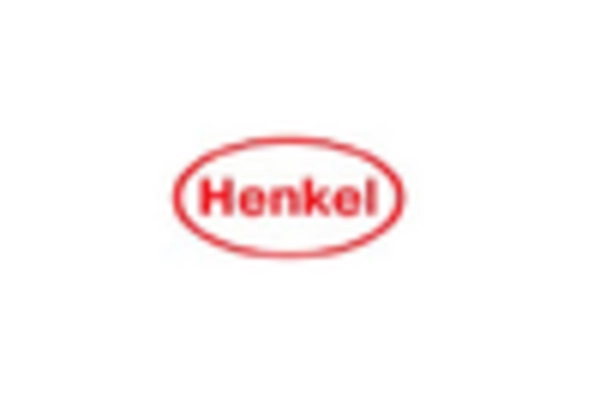Innovation in Product Formulations
Innovation in product formulations is a crucial driver for the Antibacterial Soap Market. Manufacturers are increasingly developing new and improved formulations that not only enhance antibacterial efficacy but also cater to consumer preferences for natural and organic ingredients. This trend is reflected in market data, which shows a growing segment of consumers willing to pay a premium for products that are both effective and environmentally friendly. The introduction of unique scents, moisturizing properties, and skin-friendly ingredients may further attract consumers, thereby expanding the market. As companies invest in research and development, the industry is likely to witness a continuous influx of innovative products that meet evolving consumer demands.
Rising Demand from Emerging Markets
The rising demand from emerging markets is poised to be a significant driver for the Antibacterial Soap Market. As disposable incomes increase and urbanization accelerates in these regions, consumers are becoming more inclined to invest in personal care products, including antibacterial soaps. Market analysis indicates that countries with developing economies are experiencing a surge in demand, with growth rates surpassing those in more established markets. This trend suggests that manufacturers may focus their efforts on these regions, tailoring products to meet local preferences and needs. Consequently, the industry could see substantial growth opportunities as it expands its reach into these burgeoning markets.
Increased Awareness of Hygiene Practices
The heightened awareness of hygiene practices among consumers appears to be a primary driver for the Antibacterial Soap Market. As individuals become more conscious of the importance of cleanliness, particularly in personal and public spaces, the demand for antibacterial soaps is likely to rise. Reports indicate that the market for antibacterial soaps has seen a notable increase, with a projected growth rate of approximately 5% annually. This trend suggests that consumers are actively seeking products that offer enhanced protection against germs and bacteria, thereby propelling the industry forward. Furthermore, educational campaigns by health organizations may contribute to this awareness, encouraging the adoption of antibacterial soaps as a staple in daily hygiene routines.
Regulatory Support for Antibacterial Products
Regulatory bodies are increasingly supporting the use of antibacterial products, which may significantly influence the Antibacterial Soap Market. Guidelines and recommendations from health authorities often endorse the use of antibacterial soaps in various settings, including healthcare and food service industries. This endorsement could lead to a surge in demand, as businesses and consumers alike seek to comply with health regulations. The market data suggests that regions with stringent hygiene regulations experience higher sales of antibacterial soaps, indicating a correlation between regulatory support and market growth. As such, the industry may continue to thrive as long as these regulations remain in place, fostering a culture of cleanliness and safety.
Impact of Social Media and Influencer Marketing
The impact of social media and influencer marketing on consumer behavior is increasingly shaping the Antibacterial Soap Market. As consumers turn to social media platforms for product recommendations and reviews, the visibility of antibacterial soaps has surged. Influencers promoting hygiene and wellness products can significantly sway purchasing decisions, leading to increased sales. Market data indicates that brands leveraging social media strategies experience higher engagement and conversion rates, suggesting a direct correlation between online presence and market performance. This trend highlights the importance of digital marketing in the industry, as companies adapt to the changing landscape of consumer engagement and preferences.


















Leave a Comment